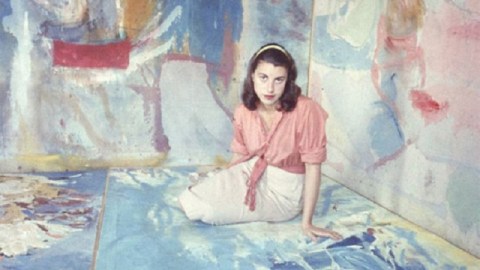How Helen Frankenthaler Blossomed Into a Great Artist

News that Helen Frankenthalerdied yesterday at the age of 83 after a long illness is making a lot of people recall just how important a figure the self-described “saddle-shoed girl a year out of Bennington” was in the history of 20th century American art. Schooled in Cezanne and Cubism during her college days, Frankenthaler found her way in the rough and tumble art world of Abstract Expressionism with a combination of personal beauty and brains that boys club couldn’t ignore. Often ignored for being too soft, too feminine in her art, Helen Frankenthaler’s death’s reminding us that a lady can be a painter, too, and a great one.
Helen grew up in New York City’s posh Upper East Side as the youngest daughter of a New York State Supreme Court judge. Surrounded by advantages, she absorbed the intellectual and cultural life around her. Helen studied in high school with Rufino Tamayo, a Mexican artist steeped in all the hot modernist movements and highly skilled in printmaking—a genre that Frankenthaler would make her own years later. Tempted to become an art historian and even going to Columbia briefly to pursue that career, Frankenthaler instead chose the more difficult road of a female artist in mid-century America.
Meeting art critic Clement Greenberg in 1950 changed the course of Helen’s life. Greenberg fell hard for Helen’s talent as much as her beauty. (Remember, supermodel Stephanie Seymour played Helen in the movie Pollock.) For the next five years, Greenberg and Frankenthaler were lovers. Greenberg introduced Helen to the burgeoning art scene and its rising stars: Hans Hofmann, Jackson Pollock, Willem de Kooning, and others. What Frankenthaler made of those opportunities, however, was all her own doing.
Helen saw her first Pollock drip painting in 1950. The idea of painting on a canvas flat on the floor intrigued her. Before you cast her as Jack the Dripper’s kid sister, however, you must recognize how she took that concept and added her own takes on Cezanne, Cubism, and other AbExes such as Rothko and how they all played games with the painting surface. Soon, Frankenthaler began experimenting with staining color directly onto unprimed canvas by diluting oil paint with turpentine and allowing the colors to bleed and combine in startling new combinations to strange and wonderful new effects. Few paintings can claim to fire the starting gun for a whole art movement, ala Monet’s Impression, Sunrise, but Frankenthaler’s 1952 painting Mountains and Sea started the movement eventually known as Color Field painting. Both Morris Louis and Kenneth Noland acknowledged Mountains and Sea as showing them the next direction art would take after Abstract Expressionism’s day in the sun.
Esteemed art critic Arthur Danto called Mountains and Sea “a painting too beautiful, to use an old fashioned word, to regard merely as a historical moment in the march forward of the modernists, and too compelling, as beauty always is, to see only as a work that influenced some important artists to begin staining canvas.” Danto saw Frankenthaler’s art as “distantly Cubist but feminized, without the harsh angles, aggressive edges, and dangerous vertices. It is like a dance of seven veils.” Whereas some, like Danto, saw Frankenthaler’s feminized Cubism positively as a creative correction to the machismo of everyone from Picasso to Pollock, many dismissed her as a painter of pretty pictures, effectively trapping Frankenthaler in a virtual prison of prettiness similar to the portrait of her surrounded on all sides by her art (detail shown above) taken by Gordon Parks in 1957 for a magazine feature on women in art.
Frankenthaler, however, refused to be dismissed. Whereas other women artists of that era, such as Joan Mitchell, Grace Hartigan, and Lee Krasner, defeminized themselves to fit in with the guys, Frankenthaler never seemed to lower herself or deny any part of her identity to belong. Helen let her art do the talking, regardless of who would listen. “For me, being a ‘lady painter’ was never an issue,” Frankenthaler said in 1972. “I don’t resent being a female painter. I don’t exploit it. I paint.” While some may say Frankenthaler exploited her sexuality to gain entry into the inner art circles and paint her as an anti-feminist, I don’t think that’s a fair assessment. If she didn’t have the talent, all the sexuality in the world couldn’t help her. Frankenthaler believed in a gender-blind art world, something that all women artists also believe in, but feel still exists only in the future. During Frankenthaler’s service on the National Council on the Arts of the National Endowment for the Arts from 1985 to 1992, many saw her conservatism as troubling. Although Helen condemned censorship, she also criticized government funding of artists such as Andres Serrano and Robert Mapplethorpe—the two main whipping boys of the Culture Wars of the 1980s. For Frankenthaler, quality, rather than sexuality or other accidents of birth, was the ultimate measure of art. (How to measure that quality and who would do the measuring, of course, remain the biggest questions.)
In the end, Frankenthaler remains a painter of pretty pictures. Like Renoir during his lifetime, Frankenthaler’s had to defend her prettiness all her life. In death, no apologies are necessary. The lyricism of works such as Mountains and Sea, as well as the underrated beauty of her 1970s woodblocks, no longer seem trite or inconsequential but rather almost restorative in the light of today’s commerce-driven art world. Helen Frankenthaler knew how to feel, and still might teach us how to feel, too.




